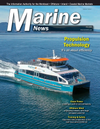
Page 16: of Marine News Magazine (July 2020)
Propulsion Technology
Read this page in Pdf, Flash or Html5 edition of July 2020 Marine News Magazine
COLUMN &5%,3
LNG as Fuel
By Joshua Padeti, ABS Senior Engineer
A snap poll recently conducted by ABS rently developing in-cylinder emissions-control strategies that found that as many two-thirds of global can be combined with after-treatment systems.
shipowners had yet to select a technical By minimizing methane slip, future fuels such as bio-LNG pathway to meet the International Mari- and SNG/RNG could offer carbon-neutral propulsion. time Organization’s (IMO) mandatory de- As a low-carbon fuel, LNG can be combined with new tech- carbonization targets for 2030 and 2050. nologies and/or operational measures to meet the 2030 emis-
With the technologies supporting a sions-reduction goals; and if blended in future with bio-LNG or myriad of new low-carbon fuels evolving SNG/RNG fuels, it also could contribute to further reductions, at vastly different speeds, any tendencies relative to the amount of renewable fuel used in the blend.
Padeti to wait for information to mature be- Given the carbon neutral promise of bio-LNG and SNG/ fore making signi?cant long-term capital RNG, the commercial application of these solutions is being commitments are understandable, and pragmatic. explored at pace.
With that in mind—and with the initial deadline for global emissions-reduction targets less than a decade away—ABS just LNG COMBUSTION published the ?rst in a series of sustainability white papers of- Environmental control areas and trans-urban waterways have fering ‘practical considerations’ to support owners with their proven attractive early testing grounds for LNG-fueled and decision making. It follows the introduction of ABS’ Three LNG-hybrid propulsion technology. Ferries, tugs and offshore
Fuel Pathways approach breaking down the way ahead into support vessels have been early adopters of the technologies.
three routes: light gas, heavy gas and alcohol and bio/synthetic. Both manufacturers of slow-speed two-stroke marine en-
It is not possible to condense all the technical information gines—MAN Energy Solutions and Winterthur Gas & Die- offered in the 24-page paper within to the constraints of this sel—offer dual-fuel options. However, each offers a different article, but here are a few insights. combustion process for operating in gas mode: a low-pressure
The Sustainability White Paper: LNG As A Fuel describes engine using the Otto cycle; and a high-pressure engine using
LNG, which is the ?rst in the Light Gas Pathway, as an op- the Diesel cycle. tion—when combined with technological and operational im- The Winterthur dual-fuel engines (X-DF) use the Otto provements—that will help owners to meet the IMO’s CO2- process in gas mode and the Diesel process when it is in oil reduction targets for 2030 (lowering ‘carbon intensity’ [CO2 mode. While the MAN engines (ME-GI) use the Diesel pro- emissions per transport work] by at least 40% against output cess in both the oil and gas modes.
from 2008); in some cases, switching from heavy fuel oil to For both concepts, the gas is ignited by a pilot injection of
LNG can reduce a vessel’s carbon footprint by as much as 20%. liquid fuel from the fuel-injection system, or from a dedicated
It is certainly the most market mature of the new fuels. pilot-fuel system.
But there are many elements to investigate when considering MAN has also announced the development of a low-pres- whether to use LNG in a shallow-draft or blue water environ- sure dual-fuel engine (ME-GA), which it intends to make ments, including vessel design, operating pro?les and technol- available in 2021. ogy advancements. The different designs lead to different performance and emis-
LNG is comprised primarily of methane. Its carbon-to- sions characteristics. But, overall, the suitability of a concept, hydrogen ratio can reduce carbon dioxide (CO2) emissions, or engine type, for a ship is very much a case-speci?c decision, but the potential 20% reduction value does not include the with the ship’s operational pro?le one of the key in?uences.
greenhouse gas impact from methane slip, a potential issue for Separately, some owners may be uncomfortable with high- two- and four-stroke engines that use LNG in the Otto cycle. pressure gas and the increased complexity and cost associated
Minimizing methane slip is critical to a wider commercial with those supply systems. Others may have concerns with the adoption of LNG and its bio-, renewable (RNG) and syn- Otto cycle’s sensitivity to a number of operating parameters thetic (SNG) derivatives, which is why the industry is cur- (methane number, ambient conditions, etc.), or the contribu-
July 2020
MN 16

 15
15

 17
17
